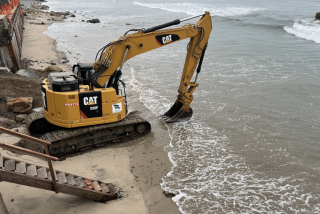Huntington Beach Broke the Law in Bulldozing Marsh, EPA Decides
- Share via
The U.S. Environmental Protection Agency has determined that the City of Huntington Beach violated federal law in December when it bulldozed three acres of valuable freshwater marshlands that provided a rare nesting habitat for songbirds.
To compensate for the damage, an agency official said, the EPA is ordering the city to replant a thicket of cattails, willows, mulefat and other wild grass that was destroyed by a controversial mosquito-abatement project at Huntington Beach Central Park.
“We felt there had been a violation of the Clean Water Act,” which requires a permit before a waterway is dredged or filled, EPA enforcement coordinator Robert Leidy said.
Leidy said that the city erred when it failed to seek a federal permit and that it should have conducted its marsh clearance project with more restraint.
“We concur that they have to control mosquitoes,” Leidy said, “but we would like to see them do it in a way that doesn’t mean they have to bulldoze all the riparian habitat. They have to do it in a way to minimize the impact to wildlife.”
City officials have promised to cooperate in restoring the marsh, Leidy said.
That was news to City Atty. Gail Hutton.
Hutton said she had not been notified of the EPA’s findings and could not say if the city will contest them. But she cautioned: “I’m not sure that, because the EPA says we’ve committed a crime, we have to jump through 50 hoops that second.”
Last month, city Parks Director Daryl Smith defended his $12,000 cleanup as necessary to eradicate rats and thousands of mosquitoes that were breeding in ponds and thick, wet grass in the park. Smith also said the bulldozing was performed at the request of county vector control officials.
Smith further argued that the federal government has no jurisdiction over management of a city park. Hutton said a staff attorney has been researching that issue.
Local bird watchers and wildlife biologists were outraged by the bulldozing, arguing that the city destroyed an oasis known as one of the best bird-watching spots in Southern California and one of Southern California’s last freshwater marshes.
Their complaints led regional officials for the U.S. Fish and Wildlife Service and the state Department of Fish and Game to investigate.
Fish and Wildlife Service officials said that about 40 species of birds regularly breed in the marsh and that about 200 species--including American lesser goldfinches, bushtits, northern orioles, warbling vireos and ruddy ducks--have been sighted there in the last four years.
Meanwhile, a state Department of Fish and Game official said that the agency is still investigating to determine if state law was violated by the bulldozing.
More to Read
Sign up for Essential California
The most important California stories and recommendations in your inbox every morning.
You may occasionally receive promotional content from the Los Angeles Times.










